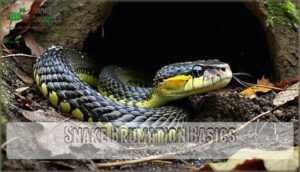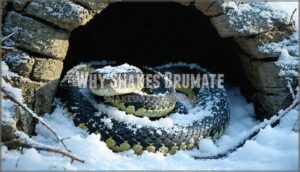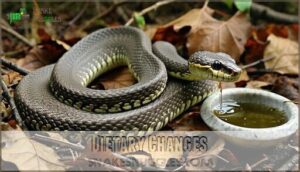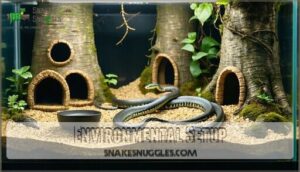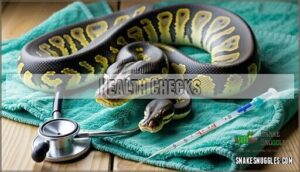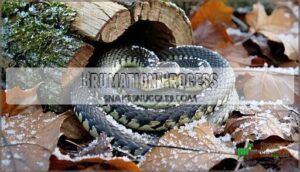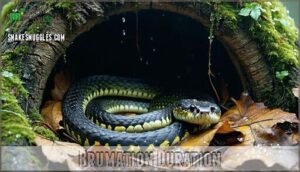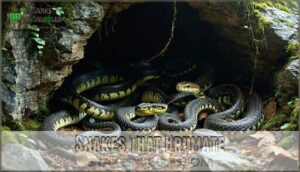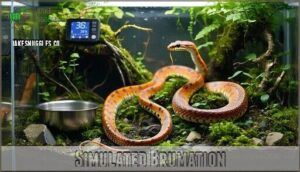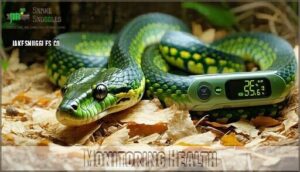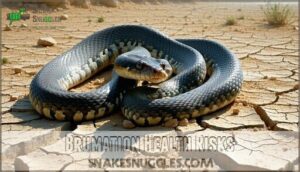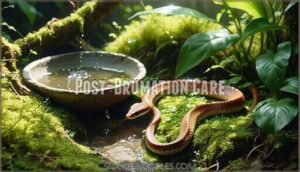This site is supported by our readers. We may earn a commission, at no cost to you, if you purchase through links.
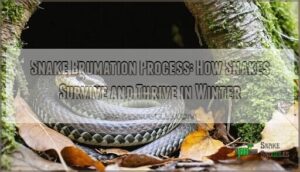 You’ll find the snake brumation process fascinating – it’s not hibernation, but similar.
You’ll find the snake brumation process fascinating – it’s not hibernation, but similar.
During winter, your cold-blooded slithery friends enter a dormant state where their metabolism slows dramatically. They’ll stop eating, move very little, and their heart rate drops.
This biological shutdown, triggered by decreasing temperatures and daylight, allows them to conserve energy when food is scarce.
Before brumating, snakes need proper hydration and fat reserves to survive for months underground, in rock crevices, or even underwater for some species.
Understanding the subtle differences between healthy brumation and dangerous health decline could literally save your serpent’s life, as it involves a dramatic slowdown and requires careful observation to distinguish from illness.
Table Of Contents
- Key Takeaways
- Snake Brumation Basics
- Why Snakes Brumate
- Pre-Brumation Preparation
- Brumation Process
- Brumation Duration
- Snakes That Brumate
- Captive Brumation
- Brumation Health Risks
- Post-Brumation Care
- Frequently Asked Questions (FAQs)
- How do I know if my snake is brumating?
- How long does snake brumation last?
- How to bring a snake out of brumation?
- How does brumation work for snakes?
- How long does brumation last for snakes?
- Should I feed my snake during brumation?
- How does temperature affect snake brumation behavior?
- What happens if a snake fails to brumate?
- Can diet impact a snakes brumation cycle?
- Do snakes need companionship during brumation?
- Conclusion
Key Takeaways
- You’ll notice snakes slow their metabolism and activity during winter to conserve energy when food is scarce.
- Proper pre-brumation preparation includes monitoring hydration, adjusting diet, and ensuring environmental cues like reduced light and temperature.
- Keep a close eye on hydration, weight, and respiratory health during brumation since snakes are more vulnerable to issues like dehydration and infections.
- After brumation, gradually warm their enclosure and resume feeding with smaller meals to help them safely transition back to normal activity.
Snake Brumation Basics
When snakes enter brumation, a survival strategy similar to but distinct from hibernation, their activity slows dramatically as they adapt to colder temperatures.
This process, influenced by environmental cues like reduced daylight and dropping temperatures, helps them conserve energy while waiting out the winter.
Brumation Vs Hibernation
Hibernation vs brumation boils down to who’s snoozing and why.
Mammals sleep deeply during endothermic sleep to survive winter, while reptiles, like snakes, enter reptilian dormancy.
In brumation, their ectothermic adaptation slows metabolic rates in response to triggering factors like cold temperatures.
Unlike mammals, snakes don’t fully snooze—they conserve energy while staying semi-alert, occasionally stirring on warmer days.
Ensuring proper temperature and humidity is essential for successful brumation.
Brumation Vs Torpor
Think of torpor as a short-term energy saver, while brumation is the reptile’s long-haul response to winter.
The snake brumation process involves deeper metabolic shifts compared to torpor characteristics, though both aim to conserve energy.
Brumation physiology adapts to environmental triggers like cold, reducing energy expenditure.
This reptile dormancy complements their coldblooded nature—unlike the fleeting torpor, brumation is a season-long evolutionary advantage.
Environmental Factors
Understanding the snake brumation process means recognizing how environmental factors influence their slowdown.
Temperature cycling, light cycles, and humidity levels simulate natural seasonal changes, signaling brumation.
A proper temperature gradient helps them regulate body heat, while altitude effects and photoperiod manipulation mimic their wild habitats.
Always monitor snake habitat temperature carefully—getting it wrong can stress snakes or disrupt their brumation state.
Why Snakes Brumate
Snakes brumate to conserve energy when food and warmth are scarce, relying on their slowed metabolism to survive harsh winters.
Snakes embrace winter dormancy, slowing metabolism to conserve energy, showcasing nature’s resilience in surviving harsh, food-scarce, cold-weather months.
This process also primes their bodies for reproduction, ensuring they’re ready to thrive when spring returns, which is crucial for their survival and involves a slowed metabolism.
Energy Conservation
In the snake brumation process, reptiles have an ingenious energy conservation trick.
Their metabolism slows dramatically, reducing activity, organ functions, and energy demands.
This dormancy period relies on fat reserves built before cooler months.
With temperature regulation adjusted, snakes can maintain their survival strategy.
Imagine pressing pause—everything calms down, but they’re still quietly functioning, saving energy for warmer days.
Survival Mechanism
Cold-blooded reptiles rely on brumation as a clever survival mechanism during harsh winters.
This snake survival strategy reflects ectotherm adaptation, where reduced activity and reptile metabolism help combat resource scarcity.
By embracing winter dormancy, they conserve energy and display remarkable climate resilience.
Think of it as nature’s way of ensuring snake temperature regulation and survival in freezing conditions when food is scarce.
Reproductive Benefits
Brumation boosts fertility and breeding success by synchronizing hormonal changes.
Snakes experience enhanced fertility rates and improved sperm production post-brumation.
Here’s why it’s key:
- Boosted Breeding Drive
- Higher Fertility Rates
- Stronger Offspring Health
- Imperative Hormonal Influence
- Optimized Reproductive Cycles
This natural process guarantees snakes are primed for a productive, healthy breeding season.
Pre-Brumation Preparation
To prepare your snake for brumation, you’ll need to focus on key steps like adjusting their diet, setting up the right environment, and ensuring their health is prime.
A little planning now helps reduce risks, leaving your snake ready for a safe and successful winter slowdown.
Dietary Changes
Before the snake brumation process begins, focus on feeding management.
Gradually increase fat intake weeks before brumation, but stop offering food three weeks ahead to guarantee digestion shutdown.
Feeding during this period can cause trapped waste, harming the snake’s digestive health.
Address hydration importance, as dehydration risks rise even with reduced feeding.
Post-brumation diets later resume with small meals.
Environmental Setup
Creating a cozy vivarium setup for the snake brumation process is key.
Focus on temperature control by gradually reducing heating and lighting. Add a substrate choice like Aspen, ensuring proper ventilation needs are met.
For a successful brumation, consider proper vivarium products. Include hiding spots to make snakes feel secure and provide water access to stay hydrated.
These tweaks help mimic nature and keep your snake comfortable through winter.
Health Checks
Before the snake brumation process, verify your snake’s health is superb.
Regular pre-brumation assessments help avoid risks.
Check these four areas:
- Monitor weight—too low, and brumation’s risky.
- Screen for parasites to avoid complications.
- Confirm hydration status since dehydration’s common.
- Check respiratory health—wheezing isn’t normal.
A healthy snake brumates better and safer!
Brumation Process
You’ll notice your snake’s metabolic rate drops dramatically during brumation, with breathing and heart rates slowing to just 5% of normal levels while their bodies conserve energy for the winter months.
During this period, they won’t eat or digest food, instead relying on stored fat reserves as they enter this dormant state triggered by decreasing temperatures and reduced daylight hours, which is a natural response to prepare for the winter months.
Reduced Activity
During the dormancy period, you’ll notice your snake’s activity reduction substantially slows.
Unlike complete inactivity, brumation involves occasional movement as snakes conserve energy.
They’ll retreat to their hides for extended periods, emerging only for infrequent water visits.
This reptile behavior change isn’t concerning—it’s a natural response to seasonal shifts.
Even in captivity, this snake inactivity period represents a pivotal survival strategy where movement is minimized to preserve essential resources, which is a result of natural response.
Metabolic Changes
During brumation, a snake’s metabolic rate drops dramatically to just 5% of normal functioning.
During brumation, a snake’s metabolism slows to a whisper—just 5% of normal—as it waits for winter to pass.
You’ll notice their heart rate slows markedly while their digestive system, liver, and kidneys almost completely shut down.
This remarkable energy conservation allows snakes to survive months without food, triggering physiological adaptations that minimize energy expenditure while maintaining just enough organ function for survival, as their enzyme activity decreases substantially.
Hormonal Shifts
While your metabolism slows during brumation, your snake’s body experiences significant hormonal shifts preparing it for future reproduction.
These changes affect everything from circadian rhythms to reproductive readiness. Ball pythons experience reduced activity and appetite during this time.
- Seasonal triggers activate hormones controlling sperm production and ovulation
- Circadian rhythm alterations regulate energy conservation while maintaining essential functions
- Reproductive hormones prepare snakes for successful post-brumation breeding
- Endocrine changes help prevent fertility issues by synchronizing breeding cycles with seasonal conditions
Brumation Duration
You’ll find that snake brumation typically lasts between 3-8 months, varying based on species, geographic location, and environmental conditions.
During this vital period, your snake’s metabolism slows dramatically to about 5% of normal levels, allowing it to survive the winter without feeding while still maintaining enough energy for essential biological functions, which is crucial for survival.
Factors Affecting Duration
Several key elements influence how long your snake’s winter rest will last.
The geographical origin of your snake plays a vital role in determining brumation duration.
| Factor | Influence | Management |
|---|---|---|
| Temperature | Lower temps extend brumation | Monitor consistently |
| Species Variation | Desert species brumate shorter | Research requirements |
| Health Condition | Healthier snakes handle longer periods | Pre-brumation check-up |
| Fat Reserves | More reserves support longer duration | Proper pre-brumation feeding |
Geographic location and age factors also substantially impact how long your snake will remain in this dormant state.
Average Brumation Period
Most snakes’ winter dormancy typically lasts between 3-6 months, though your pet’s brumation duration can vary.
In captivity, brumation lengths often mirror wild patterns, with the process unfolding across several stages from autumn to spring.
Environmental influences like temperature and light cycles substantially impact the overall period, and healthy reptile brumation usually spans from November through March, but some species may extend this essential process over seven or eight months.
Species-Specific Variations
Across the reptilian world, brumation lengths vary dramatically by species.
North American colubrids typically need around 3 months, while black and white tegus might brumate for up to 8 months.
You’ll find bearded dragons somewhere in between, with periods from weeks to 6 months.
Temperate colubrids like corn snakes may require just nighttime temperature drops, while mountain kings need consistently cooler temperatures in the 40-50°F range for successful species-specific brumation.
Snakes That Brumate
You’ll find that many snake species across North America, including milk snakes, rattlesnakes, kingsnakes, and corn snakes, engage in brumation to survive harsh winter conditions.
These cold-blooded reptiles drastically slow their metabolic processes during the colder months, allowing them to conserve energy when food sources are scarce and temperatures drop below their activity thresholds.
Milk Snakes
As winter approaches, Milk Snakes follow their instinctive brumation protocol by tracking scent trails to find crayfish burrows located below the water table.
You’ll notice these colorful reptiles stop eating completely when temperatures drop, signaling the start of their overwinter period.
During this time, their metabolism dramatically slows as they retreat to their underground hibernaculum, conserving energy until warmer conditions return in spring.
Rattlesnakes
Unlike milk snakes, rattlesnakes (Crotalus species) are renowned for their highly social brumation habits. These venomous reptiles form fascinating winter communities with their own kind and sometimes even other snake species.
During their snake winter rest, rattlesnakes:
- Return faithfully to ancestral den sites year after year
- Form groups that can number from dozens to hundreds
- Become extremely lethargic as metabolism slows dramatically
- Experience reduced venom effects during brumation
Rattlesnake brumation triggers include temperature drops and changing daylight, with regional variations affecting brumation mortality rates.
Kingsnakes
Many Kingsnakes in colder regions initiate brumation when temperatures drop to 60 degrees.
You’ll notice your captive Kingsnakes seeking out cooler spots as this threshold approaches.
They’ll emerge when temperatures rise above 60 degrees again.
Regional variations exist—Kingsnakes in moderate climates experience shorter brumation periods, while those in consistently warm areas don’t need to brumate at all.
This temperature-controlled process is essential for breeding success in many species.
Corn Snakes
How exactly do corn snakes handle winter?
During brumation, these popular pet snakes undergo distinctive physiological changes:
- They typically cease eating as autumn temperatures drop
- Their metabolic rate dramatically slows for approximately 3 months
- They enter extended sleep periods lasting weeks at a time
Corn snakes’ brumation setup requires careful temperature ranges and humidity levels.
Their natural cycle starts in autumn and concludes in spring, with post-brumation feeding resuming as they prepare for potential breeding readiness.
Captive Brumation
You’ll need to recreate natural seasonal cues in captivity if you’re planning to brumate your pet snake, ensuring appropriate temperature reduction and photoperiod changes that mimic their wild habitat.
Proper preparation includes thorough health assessments, gradual cooling periods, and consistent monitoring to prevent complications that could compromise your snake’s well-being during this critical physiological process, which involves careful management to ensure a safe and healthy brumation.
Simulated Brumation
Effective simulated brumation requires creating a controlled cooling environment that mimics natural winter conditions for your captive snakes.
You’ll need to gradually reduce temperatures and adjust the artificial photoperiod to trigger this essential process.
It’s vital to rule out underlying health issues before initiating brumation, so make certain you conduct a mandatory fecal test to ensure the snake is healthy enough for the process.
The brumation process involves several phases, each with specific requirements and monitoring needs, as outlined in the following table:
| Phase | Temperature | Duration | Health Monitoring | Key Actions |
|---|---|---|---|---|
| Preparation | Gradual cooling to 21°C | 2 weeks | Daily weight checks | Fasting period begins |
| Early Brumation | 18-20°C | 2-3 weeks | Bi-weekly checks | Reduce light hours |
| Deep Brumation | 13-16°C | 2-3 months | Weekly checks | Maintain water access |
| Emergence | Gradual warming | 2 weeks | Daily observation | Monitor for shedding |
| Recovery | Normal temps | 1-2 weeks | Post-brumation exam | Small feeding resumes |
Throughout the brumation process, it’s crucial to maintain a controlled environment and closely monitor the snake’s health to prevent any complications and ensure a successful emergence and recovery.
Environmental Control
With your simulated brumation setup in place, precise environmental control becomes your next focus.
You’ll need to create a temperature gradient that gradually decreases to 16-18°C over two weeks.
Monitor humidity levels closely while ensuring proper ventilation needs are met.
Your substrate choice should retain some moisture without becoming soggy.
Understanding the snake’s energy conservation state is key to successful brumation.
Adjust lighting schedules to mimic shortened winter days, reducing both duration and intensity.
This temperature-controlled environment signals your snake’s body to enter its natural winter state, inducing a state of energy conservation.
Monitoring Health
While your snake is brumating, you’ll need to monitor their health closely to prevent complications.
Check weight regularly (once weekly) to verify they’re not losing more than 10% of their body mass. Watch for signs of respiratory infections, dehydration, or unusual skin conditions.
Daily observations of behavior changes are vital, as is tracking defecation patterns when they occasionally wake.
Maintaining proper temperature and humidity requires a quality reptile monitoring device.
Proper reptile health monitoring during this vulnerable period can mean the difference between a successful brumation and a medical emergency.
Brumation Health Risks
You’ll need to monitor your snake closely during brumation as this dormant state can expose reptiles to serious health complications including dehydration, weight loss, and respiratory infections.
While brumation is natural and beneficial for many species, you can’t overlook the heightened vulnerability of your serpentine companion during this critical period.
Dehydration
Dehydration poses a significant risk during snake brumation, even though their metabolism slows. Your snake needs constant access to fresh water throughout this period.
- Water bowl placement should be accessible but shallow to prevent drowning
- Maintain 40-60% humidity levels to support proper hydration
- Watch for wrinkled skin or stuck shed, indicating dehydration issues
- Mist the enclosure weekly if humidity drops too low
Weight Loss
During brumation, your snake’s weight loss requires careful attention.
While some reduction is normal as they use fat stores, excessive weight loss signals trouble.
Monitor your snake’s body condition regularly—a 10-15% decrease is typically acceptable loss, but anything more warrants investigation.
Cause identification becomes critical if weight drops dramatically.
Implement intervention strategies promptly to preserve your snake’s health during brumation, ensuring they’ll regain appropriate post-brumation gain when activity resumes.
Infections
Why are infections such a serious concern during brumation? During this vulnerable period, your snake’s immune system operates at minimal capacity, making it susceptible to health issues.
Fungal and bacterial infections often worsen during winter rest periods.
Four critical infection risks during brumation include:
- Respiratory infections from cool, damp conditions
- Fungal infections spreading through communal hibernacula
- Bacterial infections worsening in sluggish immune systems
- Parasitic infections becoming more severe in weakened hosts
Post-Brumation Care
You’ll need to gradually increase enclosure temperatures and light cycles after your snake emerges from brumation, ensuring a smooth shift back to normal activity levels.
Once your snake completes its post-brumation shed, you can resume feeding with smaller prey items than usual, monitoring carefully for proper digestion as its metabolism reactivates.
Gradual Warming
Once the risks of winter dormancy have passed, it’s time to coax your reptile friend back to regular activity.
Successfully ending brumation requires a gradual temperature increase rather than sudden warming.
| Day | Temperature Adjustment | Environmental Change | Behavioral Signs | Monitoring Needs |
|---|---|---|---|---|
| 1-7 | +1°C every other day | Minimal light exposure | Limited movement | Hydration checking |
| 8-14 | +1°C daily | 8 hours light cycle | More alert posture | Weight assessment |
| 15-21 | +2°C until target | 10-12 hours light | Active movement | Shedding cycle watch |
| 22-28 | Maintain day/night cycle | Full lighting schedule | Tongue flicking | Temperature control |
| 29+ | Normal temperature range | Normal photoperiod | Regular behavior | Activity monitoring |
Resumed Feeding
After slowly raising temperatures in your snake’s enclosure, you’ll need to restart their feeding schedule carefully.
Wait 1-2 weeks after reintroducing heat, then offer a smaller-than-normal prey size. Don’t rush this process—your snake’s digestive system needs time to reactivate after brumation.
Understanding the importance of temperature regulation is key to a successful shift. Once they’ve successfully digested their first meal, you can gradually return to their regular feeding schedule.
Remember, proper hydration is critical during this postbrumation care period, so always provide fresh water as your snake’s metabolism returns to normal.
Frequently Asked Questions (FAQs)
How do I know if my snake is brumating?
You’ll notice your snake becomes less active, stops eating, and seeks cooler spots in its enclosure.
It’ll move sluggishly when disturbed and might soak more frequently.
These behaviors typically coincide with seasonal temperature changes, and are a sign that your snake is undergoing a natural process, often related to temperature.
How long does snake brumation last?
Snake brumation typically lasts 3-8 months, depending on species and climate.
You’ll notice your snake’s dormant period usually beginning in fall (September-December) and ending in spring (March-April) when temperatures naturally rise again, which can be considered a period of brumation and occurs when temperatures naturally rise.
How to bring a snake out of brumation?
Gradually guide your garden guest back to activity by slowly raising temperatures 1-2°F daily.
Provide plenty of water and patience – you’ll need to wait until they’ve had their post-brumation shed before offering food.
How does brumation work for snakes?
During brumation, your snake’s body dramatically slows down in response to colder temperatures.
They’ll reduce activity, stop eating, and lower their metabolic rate to conserve energy through winter.
While remaining minimally aware of their surroundings.
How long does brumation last for snakes?
Ever wondered how long your snake’s winter vacation lasts?
Brumation typically continues for 3-8 months, depending on your snake’s species and native climate.
Most snakes are active again by April after their metabolic slowdown, with brumation usually ending around this time.
Should I feed my snake during brumation?
No, you shouldn’t feed your snake during brumation.
Their digestive system slows markedly, and undigested food can rot in their system.
Wait until temperatures rise and your snake becomes active again before offering food.
How does temperature affect snake brumation behavior?
Temperature is like the maestro of brumation.
Too high, and your snake skips dormancy entirely.
Dip it too low, and health risks spike.
The sweet spot—16-18°C—keeps their metabolism low and behavior safely on track.
What happens if a snake fails to brumate?
If a snake skips brumation, its natural rhythms might get disrupted, leading to reduced breeding success or hormonal imbalances.
It could stay active but stressed, draining energy reserves and possibly weakening its overall health long-term.
Can diet impact a snakes brumation cycle?
Imagine overfeeding a snake before winter—it’s like stuffing yourself at a buffet before a marathon.
A high-fat diet boosts energy reserves, ensuring safer brumation, but undigested food risks serious health issues, even infections, due to undigested food.
Do snakes need companionship during brumation?
Snakes don’t need companionship during brumation.
They naturally brumate solo, even in group settings.
Grouping snakes can lead to stress or competition for resources, so it’s best to provide individual spaces for their comfort.
Conclusion
Winter’s chill doesn’t spell doom for snakes—it’s their time for a well-earned metabolic nap through the fascinating snake brumation process.
By slowing their systems and conserving energy, they adapt to scarce resources, a strategy both practical and ingenious. Whether you’re observing wild snakes or caring for captive ones, understanding brumation guarantees their health and survival.
So, keep an eye on hydration, weight, and environment, and you’ll help these remarkable reptiles thrive through colder months.
- https://www.torontozoo.com/adoptapond/snakehibernacula.asp
- https://www.reptiles.swelluk.com/help-guides/bearded-dragon-brumation-explained/
- https://www.youtube.com/watch?v=nIsVll7Do64
- https://www.reddit.com/r/tortoise/comments/1aslk35/toms_brumation_thread_how_to_safely_hibernate/
- https://elifesciences.org/reviewed-preprints/88236v1

